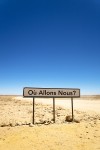“Où Allons Nous?”
Though the roadside sign in a 1953 photograph stands alone, its message does not. It joins the dialogue of three centuries’ worth of rich textures, colors, figures and images, presenting a question that connects us all to the vulnerable earth we inhabit, “Where are we going?”
On Tuesday, coinciding with Earth Day, the Fowler Museum at UCLA premieres “Earth Matters: Land as Material and Metaphor in the Arts of Africa.” A traveling exhibition of more than 100 works, this array of African art ranges from the 19th to the 21st century. A variety of visual mediums, from sculpture to video, exemplifies the many connections African peoples in historic and contemporary times have had with the earth.
“It’s really an exhibition that is ambitious in its attempts to encompass the breadth of people’s relation to the environment,” said Gemma Rodrigues, curator of African arts at the Fowler Museum.
The realization of the exhibition took extensive research, including travel to numerous African countries, from Morocco to South Africa, said Karen Milbourne, a curator at the Smithsonian Institution’s National Museum of African Art. It was from these travels and collaborations with curators, artists and scholars that the structure of the exhibition was created for host venues such as the Fowler Museum.
Milbourne said she originally conceived the idea for the exhibition in an attempt to bring focus to that which is oftentimes overlooked: human beings‘ relationship to the land.
One work that presents the complexity of this relationship is a 1974 photograph by photographer George Osodi that is part of his “De Money” series. In the image, miners in Ghana are perched precariously along the side of a mining pit.
“It’s just a very powerful image that speaks to the kinds of risks people are willing to undertake to just earn a living,” said Rodrigues. “So often people will find themselves in a position where they are caught … between the need to conserve the environment and the need to earn a living.”
Other works also relay the implications of how a human being’s fate can coincide with that of the land. One such piece, “Mine Shaft and Slave Ship” by artist William Kentridge, is a 1955 work crafted from charcoal and pastel on paper that displays a tightly packed slave ship in the form of a mine shaft.
The legacy of the slave trade was largely an issue of who has access to the land, Milbourne said. The earliest artwork of the exhibition purposefully dates back to 1807, the year the international slave trade was banned.
The hope to depict the complex thematic topics inspired by the peoples and lands of Africa through art is shared by those who work to host “Earth Matters” at the Fowler Museum. Rodrigues said the exhibition could allow audiences to think deeply on how different peoples in different societies have forged a relationship with the environment.
“This is a really great opportunity because it really deals with the earth and environmental issues, which are universal things people can really think about and take something from,” said Gregory Sandoval, curator of public programs at the Fowler Museum.
Rodrigues said she hopes viewers develop an understanding of global connection.
“One thing that strikes me that people could get from this exhibition is perhaps a deeper appreciation of how interconnected all of our lives and futures are, even though we inhabit different parts of the globe,” Rodrigues said.
Milbourne said “Earth Matters” allows audiences to see how artists are active individuals who can relay connections through their art and instigate change by allowing it to be seen as a vehicle for environmental activism.
“You can recognize personal questions if you can think about your own personal connection to the land (and) its power,” Milbourne said. “Then we can start to consider for ourselves, ‘Where do we want to go?'”
